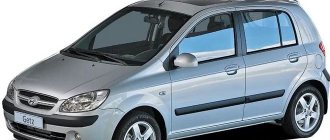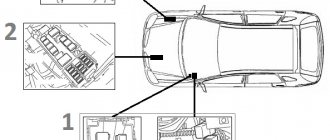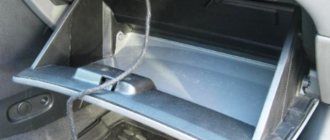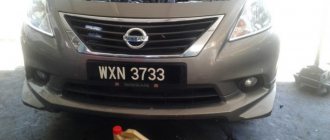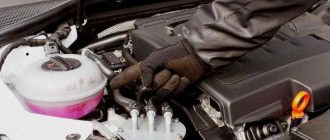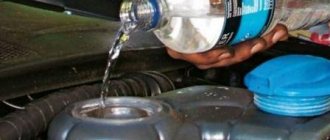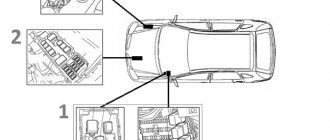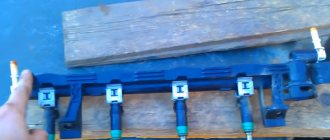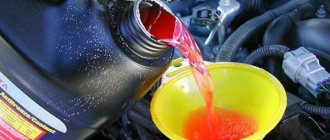Replacing the coolant (hereinafter referred to as coolant) in any car is an important part of the technical work. Therefore, special attention should be paid to the choice of antifreeze, in particular when it comes to Nissan cars. Today you will learn how to replace Nissan Almera Classic antifreeze, what is needed for this and what refrigerant is best to fill.
Replacing consumables includes not only the direct process of technical work, but also preparation. When preparing to change the coolant, you need to know which fluid is best to fill, how much of it is needed, and you also need to prepare everything that may be useful in the process.
Car Nissan Almera Classic
How to change antifreeze Almera Classic
You need to place the car on a flat surface and unscrew the radiator cap. Then remove the left engine splash guard. After this, place a container under the hose of the drain valve (located on the left side of the lower radiator tank) of the engine radiator, unscrew the cap and drain the coolant from the radiator. Then tighten the plug back.
Then move the container under the drain hole of the cylinder block, located on the left side of the block near the 4th cylinder. Here you also need to unscrew the plug, drain the antifreeze, and tighten the plug.
Next, unscrew the cap of the expansion tank and pump out the remaining coolant using a bulb or syringe. Then flush the cooling system with distilled water, pouring it into the radiator neck. Start the engine and let it run until the fan turns on. Rinse until clear water comes out.
Next, pour antifreeze into the radiator up to the level of the vapor exhaust pipe. Then start the engine so that the fan turns on, and add antifreeze as it decreases. Then tighten the radiator cap and add coolant to the expansion tank to the maximum level. Turn off the engine, let it cool, and then check the antifreeze level in the tank and top up if necessary.
Useful tips when replacing Almera Classic antifreeze
If the coolant expansion tank is dirty, it should be removed and washed.
When the engine is running, it is worth monitoring the coolant temperature scale. If the arrow is in the red zone and the fan does not turn on, you should turn on the stove and check what kind of air is flowing. Warm means the fan is faulty; cold - there is an air lock in the system.
Also, after a few days it is worth checking the level and color of antifreeze in the tank. If it has dropped, top it up; if it has changed color in such a short time, it means it’s a fake and needs to be replaced.
How to remove an air lock Almera Classic
You need to unscrew the radiator cap with the engine off and cold. Then start the engine, let it run for about five minutes, and tighten the plug.
In order to replace the Almera Classic antifreeze without the formation of air locks, it is worth pumping the radiator hoses by hand.
Which antifreeze should I choose and how often should I change it?
The first antifreeze replacement after purchasing a car should be done after 90,000 km. At this time, access to the maintenance and repair of Almera Classic is already allowed to any auto repairmen. Next, the cooling composition is changed every 3 years, or every 60,000 km.
Car manufacturers always recommend using only special coolant for replacement. In this case, this is the original coolant for Nissan L248 Premix 1l-KE90299935, 5l-KE90299945. In case there is no original, we will indicate another option L250 Premix 1L-KE90299934, 5L-KE90299944, and if this is not available, then you can use Ravenol concentrate 4014835755857 as a full replacement for the “native” composition.
The Almera Classic cooling system holds 6.7 liters of coolant (total).
Which refrigerant to choose for Nissan Almera Classic?
The procedure for replacing coolant on a Nissan Almera Classic is carried out after selecting a suitable fluid. It is recommended to use original L250 refrigerant. It is this type of consumable that meets the requirements set by Nissan manufacturers for the vehicle cooling system. They believe that the cooling system plays an important role in the operation of the car over a long period.
Nissan L250 is a liquid that prevents the formation of corrosion on the internal walls of the system, and also prevents leakage and boiling of consumables.
The liquid is manufactured based on international standards. Thanks to this, it ensures long-term performance of the cooling system. The color of the original liquid is green.
Changing antifreeze in Almera Classic
Concentrate is often chosen when it is necessary to replace antifreeze in Almera Classic for several reasons. The concentrate is especially good when changing the composition requires flushing the entire system.
At the same time, when filling the cooling system with a concentrate solution, keep in mind that after washing there is always some amount of distilled water remaining in it.
Car enthusiasts fill Almera Classic with simple coolers and assure that the car works normally after such a replacement. However, the car manufacturer does not recommend this. And saving a penny today turns into serious problems in the future. Any replacement of original compositions with surrogates is fraught with trouble.
How is old coolant drained?
Replacing the coolant is not difficult. But there are nuances that should be taken into account. First, let the car cool down for 20 minutes. Next follow 5 steps:
- The cooling radiator plug in the lower right corner is unscrewed. A large bowl should be placed under it, into which the used composition will be drained. It is better to remove the crankcase protection, otherwise there will be a big spill. It is best to carry out the replacement procedure by placing the machine on a special drain pit.
- The radiator cap is unscrewed and coolant begins to pour out in a continuous stream.
- The plug is unscrewed from the cylinder block so that the remaining antifreeze also pours out.
- The bypass plug is unscrewed from the thermostat to drain any residues hidden there.
- The expansion tank is unscrewed, the cap is removed from it and then it rises to a height of 30 centimeters above the radiator so that all the remainder goes from the connecting tubes into the radiator.
What happens to the car if there is not enough antifreeze?
Antifreeze contains water. Over time it may boil away. The refrigerant level may decrease. If the level is not enough, this is the first reason for overheating. Urgently needed to be added.
Modern cars, including Nissan Almera, are equipped with special protection sensors. Overheating is difficult to prevent, but possible.
The temperature sensor needle will exceed the permissible limit. There will be white steam coming from under the hood. The liquid has boiled and will begin to evaporate. The engine will run intermittently.
If it overheats, major repairs may be required as the engine may seize. Therefore, from time to time it is necessary to check the fluid level in the system and prevent overheating of the power unit.
Stages of replacing coolant Nissan Almera Classic
If you follow everything step by step, then replacing the old fluid with a new one does not present any difficulties. All drain holes are located quite conveniently, getting to them is not difficult.
This car was produced under different brands, so the replacement will be the same for:
- Nissan Almera Classic B10 (Nissan Almera Classic B10);
- Samsung SM3 (Samsung SM3);
- Renault Scala.
Coolant drain
To carry out the procedure for draining used antifreeze, you need to take the following steps:
- Below, next to the pipe going to the radiator, there is a special drain valve (Fig. 1). Unscrew it so that the liquid begins to drain. There is no need to remove the engine protection; there is a special hole in it.
When replacing antifreeze on a Nissan Almera Classic, the maximum amount of liquid is drained in this way. Of course, some part remains in the branched channels of the engine; it cannot be drained, so flushing is necessary.
Flushing the cooling system
After draining the used antifreeze, it is advisable to flush the system. Since various deposits can form in the radiator, its pipes and pump over time. Which over time will not allow antifreeze to circulate normally through the cooling system.
It is advisable to carry out the internal cleaning procedure of the cooling system every time you replace antifreeze. To do this, you can use distilled water or special products. But in most cases, if replacements are made according to regulations, distilled water is sufficient.
In order to flush the cooling system, you need to pour distilled water into the radiator and expansion tank. Then start the Almera Classic B10 engine and let it run for a few minutes until it warms up. So that the thermostat opens and the liquid flows in a large circle. Next, drain it and repeat the washing procedure several times until the color of the water when drained is clear.
Filling without air pockets
We check that all drain holes are closed, leaving the bypass valve on the thermostat open:
- pour antifreeze into the expansion tank to the MAX mark;
- We begin to slowly pour new fluid into the radiator filler neck;
- as soon as antifreeze flows through the air vent hole left open, located on the thermostat, close it (Fig. 5);
Now you can start the engine, warm it up to operating temperature, periodically increase the speed, add a little gas. The pipes going to the radiator after warming up must be hot, the stove, turned on for heating, must blow hot air. All this indicates the absence of air locks.
If something goes wrong and air remains in the system, you can use the following trick. Insert a paper clip under the bypass valve located in the radiator cap, thereby leaving it open.
After this, we start the car, wait for it to warm up and accelerate a little or drive in a small circle, increasing the speed. This way the air lock will come out on its own, the main thing is not to forget to take out the paperclip. And of course, we check the coolant level in the expansion tank again.
Replacing the pump, belts and antifreeze — Nissan Almera, 1.8 l., 2006 on DRIVE2
My pump was leaking for a long time, it didn’t really bother me, but in the cold weather the heater started to heat up poorly at idle, and yet I decided to change it and at the same time the belts. Everything is ordered
I won’t specifically describe how to change and disassemble everything, it’s all available in bulk on the Internet, I’ll just post some of my photos and a little description of them. Since I prefer to parse it a little more, but it will be more convenient for me to do it, I did it like this:
Removed the protection, removed the wheel, and remove this fender liner
We unscrew two bolts and remove several pistons from this protection
here only to make it convenient to drain antifreeze
rollers at your fingertips, you can remove the straps
The belts are off, time to drain the antifreeze, first I removed this hose
then from the bottom of the radiator (no photo) and tried to pour everything into a bottle... it didn’t work
unscrew the roller from the pump, it is secured with 4 bolts (ATTENTION, YOU MUST LOSEN THE BOLTS WHEN THE BELT IS TENSIONED, otherwise it won’t work, I tried))))
The next photo shows how, for convenience, I moved the power steering fluid reservoir and expansion tank aside, it was more convenient for me.
the pump is mounted on 6 bolts, some long and some shorter, do not mix them up. There is no photo of how to unscrew it, but almost everything except two is easier to unscrew from above
stripped off
you can compare the new pump and the old one, for some reason their impellers are made slightly differently
We assemble everything in the reverse order: screw on the pump, the roller, put on and tighten the belts (new ones in my case), tighten the pump roller, return all the tanks to their place, put on the hoses, fill in antifreeze, start it, nothing leaks, replace the fender liners, protection, we expel the air lock and that’s it. )))
By the way, if someone doesn’t have a pit or a lift, everything can be done from under the hood, but you’ll have to break your hands and fingers)
Replacement frequency, what antifreeze to fill
If you follow the regulations described in the maintenance instructions, then the first replacement should be carried out no later than 90 thousand mileage or 6 years of operation. All subsequent replacements must be carried out every 60,000 kilometers and, accordingly, 3 years.
The manufacturer recommends using the original Nissan Coolant L248 Premix fluid for replacement. You can also use Coolstream JPN antifreeze, which, by the way, is used as the first fill at the Renault-Nissan plant located in Russia.
Many owners choose RAVENOL HJC Hybrid Japanese Coolant Concentrate as an analogue; it also has Nassan approvals. This is a concentrate, so it is good to use if a wash was used during the change. Since there is some distilled water left in the system, the concentrate can be diluted with this in mind.
Basic Rules
The fastest time to fill antifreeze by professional staff is 1.5 hours. It is worth remembering that the type of liquid and its color are different definitions, and during subsequent refills you need to mix exactly the same type, and not those that have an identical dye.
It is always necessary, without exceptions or adjustments for circumstances, to use the original formulations. Cheap antifreezes contain a large number of additives that form scale, leading to corrosion and destruction of the walls of car parts.
It is strictly forbidden to use any types of liquids other than those recommended! Water and other mixtures that gullible car owners try to pour into the radiator have an unacceptably low boiling point.
If the replacement date has not yet arrived, and the car’s behavior is causing concern, you should have the vehicle diagnosed and properly serviced as soon as possible.
Choice of antifreeze
When replacing it yourself, the question arises of what antifreeze to fill. For Nissan Almera N16 and Classic, the manufacturer recommends Nissan Coolant L248 Premix. Previously it was called Coolant L250 Premix. The liquid is green.
At Russian Nissan-Renault factories, Coolstream JPN is filled, so this fluid is also suitable as a replacement. Also, Ravenol HJC Hybrid Japanese Coolant PREMIX or Concentrate meets all tolerances.
Whatever fluid is selected must comply with Japanese Industrial Standards.
But you shouldn’t choose by color (change yellow for yellow, red for red, etc.). Because there are no standards regarding coolant coloring. Its color has nothing to do with its characteristics.
How much antifreeze does it take to replace? In the Nissan Almera Classic the volume is 6.7 liters. The N16 with different types of gasoline engines has the same number. For diesel 1.5 - 7.2 l of coolant, for diesel 2.2 - 8.7 l.
Getting ready for replacement
Replacing consumables includes not only the direct process of technical work, but also preparation. When preparing to change the coolant, you need to know which fluid is best to fill, how much of it is needed, and you also need to prepare everything that may be useful in the process.
Car Nissan Almera Classic
What kind of coolant should I use?
If you do not know what antifreeze you should use in your car, then read the information provided below. For Nissan Almera Classic cars, as for any other foreign car, it is recommended to use only high-quality antifreeze. The use of refrigerants based on ethylene glycol is allowed; as a rule, the brand of coolant is indicated in the instructions for the vehicle.
The manufacturer recommends filling your vehicles with original Nissan L250 refrigerant. As you know, this consumable material fully meets the requirements of the cooling systems of Nissan Almera Classic cars. Its reliability and performance largely depend on the cooling of the machine’s power unit, so the choice of coolant should be approached very carefully and responsibly. Nissan L250 helps prevent corrosion on the internal walls of cooling system components, as well as leaks and boiling of consumables.
Original coolant for Nissan
The fluid has been produced in accordance with international standards and is able to ensure a long service life of the cooling system of your Nissan. The color of the original products is green, but this does not affect the characteristics of the refrigerant.
If you are not able to purchase the original product in your city, then contact the dealer or order it online. If you cannot do this for some reason, then select analog products that meet the specifications of your car.
Note! Today there are many types of coolants on the domestic car market, but not all of them meet the requirements of Nissan Almera. Refrain from purchasing if you are not sure that this is an original product.
Line of original antifreeze for Nissan
Instructions
You can replace the coolant either at a service center or yourself. It is not difficult to drain antifreeze from this car model; the main thing is to know the location of the system components. A similar scheme will be for the following cars:
- Nissan Almera Classic;
- Nissan Almera Classic B10 (Nissan Almera Classic B10);
- Samsung SM3 (Samsung SM3);
- Renault Scala;
- Nissan Almera H16.
The difference will be, perhaps, in the volume of liquid poured and some nuances.
Coolant drain
Before replacing antifreeze, it is necessary to drive the car into an inspection pit and allow the engine to cool completely. Then:
- Remove engine protection from Nissan Almera N16. The “classics” don’t need it.
- Place a container under the drain hole. The classic Almera has a special tap; on the 16th, you need to remove the pipe at the bottom of the radiator on the driver’s side.
- Remove the caps from the expansion tank and radiator.
- Some of the liquid will definitely remain in the expansion tank. Therefore, it is best to remove it and wash it.
- Then you need to drain the coolant from the engine block. To do this, unscrew the plug near the collector protective casing.
- Unscrew the valve on the thermostat housing to allow air to escape.
These manipulations allow you to free the system as much as possible from coolant. After this, you need to remember to put all the plugs and plugs in place.
Flushing the cooling system
Even after all the manipulations described above, it is impossible to completely drain the coolant. Some part of it will definitely remain in the system. It will mix with the new liquid and deteriorate its quality. Or it won’t mix - if, for example, a carboxylate one is poured after the silicate one. Therefore, it is recommended to do rinsing. This is especially important when switching to another brand or type of antifreeze.
Cleaning is easy. It is necessary to replace all plugs, covers and pipes that were removed during draining. Fill the radiator and expansion tank with distilled water and close them too. Start the engine, warm it up, then drain the water. Repeat this several times until the water stops changing color and becomes clean and transparent.
Before pouring, leave the hole above the thermostat open. Then carry out the following steps:
- Pour antifreeze into the neck of the expansion tank. It should be at a level approximately between the maximum and minimum marks. Close the lid.
- Begin to slowly pour fluid into the radiator.
- When antifreeze flows out of the hole above the thermostat, close it.
- Fill the radiator to the top and close the lid.
After these steps, you need to start the engine and warm it up at 3000 rpm. Then let it cool and check the coolant level in both the tank and the radiator. Top up if necessary.
This scheme should eliminate the appearance of air jams. It's easy to check whether they exist or not. After warming up, the pipes that go to the radiator should be hot, and the stove should release hot air. If there is still air in the system, you must leave the radiator bypass valve open. You can insert a paperclip under it. Then drive a little and accelerate. After this, the cork will come out, you can remove the paperclip. And check the coolant level.
